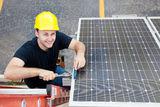Going Green on Your Own

National, community and utility-wide efforts to move toward greater renewable energy use are well publicized. However, many consumers are becoming frustrated with the relatively slow pace of those authorities and are looking for ways to pursue renewable energy use on their own, perhaps even with a goal of being "off the grid."
But how can an individual consumer turn their back on a monolithic energy supply and generation infrastructure that has been over a century in the making? Solar generation is the most popular type of renewable energy for individual consumers, and wind generation is also becoming more popular on an individual basis. There are also possibilities of residential generation from hydro and geothermal sources.
Solar
Solar is the fastest growing source of renewable energy. In most large communities one can find solar panels mounted on the roofs of houses. According to the Solar Energy Industries Association (SEIA), residential installations of photovoltaic (PV) solar panels increased 61% in 2012.
Historically, one of the main barriers to solar power on an individual consumer level has been price. Again, according to SEIA, the average price of installed PV solar panels has dropped 33 percent in the past three years. Also, some consumers are now able to lease solar installations on their homes rather than buying them outright. In some cases installation can actually be of no charge to the consumer, and energy savings are split between the home owner and the leasing company.

Source: SEIA Q1 2013 Fact Sheet
Wind
Wind power generation is the second most popular renewable energy generation source for individual consumers in the US. Though windmills and turbines are usually associated with rural areas, urban and suburban areas also have potential for wind energy production.
Like solar power, wind power generation systems can be expensive to install. Luckily, consumer scale wind turbines are frequently subject to the same renewable energy tax incentives that solar systems are. And also like solar, product and installation prices are coming down.
Wind turbines also require more physical space. While some towers may only take up a couple of square yards of tower space or are even mountable on a building, the US Department of Energy recommends 1 acre of land to support a small wind generation system. Local building codes also need to be consulted to verify how tall the tower can be.
Other Sources
A hydropower system on an individual consumer level requires a very specific set of geographic circumstances, including water which courses through the property at a steep enough descent to move a turbine. Hydropower is extremely efficient and has almost no waste, however systems on an individual consumer scale are rare.
Similarly, availability of geothermal energy for generation is greatly dependent upon geographic circumstances and is most frequently employed on a large, grid-wide basis.
Energy Supply
Even if consumers are not able or do not choose to install a private renewable energy system in their homes there are still options to ensure that energy supplies are derived from renewable sources. Renewable Energy Certificates can be purchased, ensuring that the consumer's share of energy use is derived from renewable sources. Also, when choosing a third party supplier, consumers can indicate that they wish their power to come at least partly, if not completely, from renewable sources (BUE is the premier energy supply consulting firm in North America, and can ensure your provider uses renewable sources).
Consumers have an unprecedented variety of choices for energy providers and sources. We are now able to choose who produces our energy, from what sources that energy comes, or even to produce it ourselves. More than ever, we are able to make our energy uses match our personal values and priorities, especially enjoying the benefits of renewable resources.
Copyright © 1996-2013 by CyberTech, Inc. All rights reserved.
To subscribe or visit go to: http://www.energycentral.com
To subscribe or visit go to: http://www.energybiz.com
http://www.energybiz.com/article/13/10/going-green-your-own